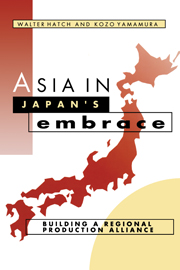Book contents
- Frontmatter
- Contents
- List of Tables
- List of Figures
- Preface
- Part One Co-Prosperity Again
- Part Two The Embracer and the Embraced
- 3 Cooperation between Unequals
- 4 The Political Economy of Japan
- 5 The Political Economy of Asia
- 6 Holding Technology
- Part Three A Japanese Alliance in Asia
- Part Four A Powerful Embrace
- Notes
- Select Bibliography
- Index
5 - The Political Economy of Asia
Published online by Cambridge University Press: 05 February 2012
- Frontmatter
- Contents
- List of Tables
- List of Figures
- Preface
- Part One Co-Prosperity Again
- Part Two The Embracer and the Embraced
- 3 Cooperation between Unequals
- 4 The Political Economy of Japan
- 5 The Political Economy of Asia
- 6 Holding Technology
- Part Three A Japanese Alliance in Asia
- Part Four A Powerful Embrace
- Notes
- Select Bibliography
- Index
Summary
It has become axiomatic: following Japan's flight path, the other capitalist nations of the Asia-Pacific region have achieved, or are about to achieve, economic “lift-off” – an upward trajectory that has allowed them, or soon will allow them, “to escape the mire of perpetual ‘developing’ status.” In almost perfect harmony, scholars and journalists say that the nations of Northeast Asia, particularly South Korea and Taiwan, have already accomplished this aerodynamic feat and now are soaring “somewhere over or near the threshold of advanced industrial development.” Consequently, they are hailed as NICs, “tigers,” or “little dragons.” The nations of Southeast Asia, particularly Thailand, Malaysia, and Indonesia, are said to be rolling down the runway and gearing up for take-off. They in turn are known as new NICs, “new tigers,” or “new little dragons.”
If there is any serious disagreement about the economic development of Asia, it has to do with why so many of the region's capitalist countries have managed to fare so well. Predictably, neoclassical economists say the NICs have succeeded, and ASEAN members are beginning to succeed, by relying more on the private sector, encouraging exports, eliminating government-induced price distortions, and adopting prudent macro-economic policies. In other words, they are doing well by hewing to the free market. Just as predictably, many political scientists attribute the region's success to authoritarian and technocratic regimes that have managed to defy special interests and impose rational, if sometimes painful, economic policies.
- Type
- Chapter
- Information
- Asia in Japan's EmbraceBuilding a Regional Production Alliance, pp. 77 - 96Publisher: Cambridge University PressPrint publication year: 1996

